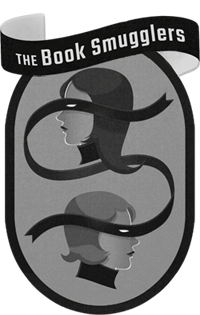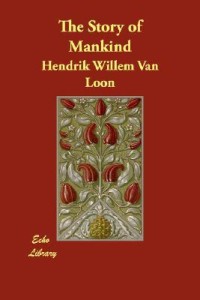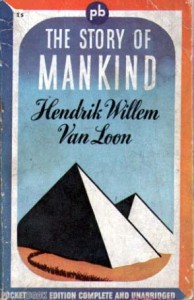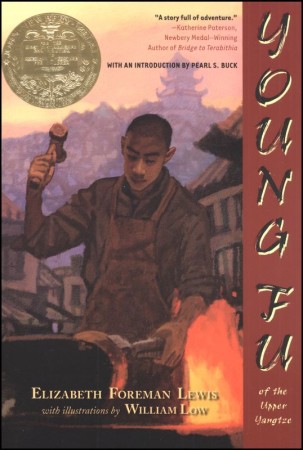Decoding the Newbery is a monthly column in which Newbery Medal winners are examined and deconstructed by regular contributor and author Catherine Faris King.
This month, Catherine examines the first ever book to be awarded the Newbery Medal: The Story of Mankind, by Hendrik Willem Van Loon.
“I want you to learn something more from history than a mere succession of facts. I want you to approach all historical events in a frame of mind that will take nothing for granted. Don’t be satisfied with the mere statement that ‘such and such a thing happened then and there.’ Try to discover the hidden motives behind every action and then you will understand the world around you much better and you will have a great chance to help others, which (when all is said and done) is the only truly satisfactory way of living.”
Hendrik Willem Van Loon, The Story of Mankind, “The Holy Alliance.”
It’s very appropriate that the first work ever honored by a Newbery Medal should have been a look at the entire history of mankind, from prehistory to the time of publication. It’s great for posterity – deeply educational, resistant to literary trends and momentary fads. It’s noble and far-reaching all at once. The fact that Hendrik Willem Van Loon was a Dutch-born naturalized American citizen is also fitting for an American award – even old New York was once New Amsterdam, after all.
But how does the work itself hold up? The Story of Mankind just passed its ninety-fourth birthday. It predates the Newbery Formula and, as most works of nonfiction do, completely averts it. Has it aged well with the years, or does it remain a product of 1921?
By and large, I have to admit that The Story of Mankind, as written by Hendrik Willem Van Loon for a very specific audience (his grandchildren), is pretty much exactly what you would expect a history of the world to be, as written by a white, Christian, European man in the 1920’s.
In a word, problematic.
So the book opens with the genesis of life on earth, and a heady montage of evolution wherein creatures decide to develop a trait, and they pass on that decision to their offspring. Civilization begins in the Egyptian River Valley. The focus of the book traverses the Mediterranean a bit before settling in Western Europe, there to rest until Russia and North America become worthy of mention. In terms of civilization, there’s nothing further south than Egypt or further east than Asia Minor. When it comes to the American colonies, Native Americans aren’t even mentioned.
It takes eighty-eight pages before he names a woman and gives her any kind of agency and a story of her own. That woman, if you’re curious, is Maha Maya, the mother of the Buddha. It took me by surprise. Cleopatra didn’t count; as far as Van Loon is concerned, she was a flirt who tried and failed to seduce her way to national security.
He leaves the subject of religion mostly alone, until he takes an interlude in the middle of the Roman Republic. He invents a letter between Roman officials – the only time he departs from his third-person, detached narration. The letter-writer describes the life, and specifically the death, of a certain Joshua of Nazareth, whom some called “the Christ.” The writer of this letter presents Pontius Pilate as an innocent, overtaxed politician and blames Jesus’ death squarely on the Jews, “lashed into fury by their priests” and “frantic with rage.” Um, yikes. I have never been so glad for the existence of Elizabeth George Speare’s Newbery winner, The Bronze Bow (1962). It certainly isn’t a favorite of mine, but now I really appreciate her setting her story among the Israelites of first-century Judaea, an oppressed people seeking revolution, who have their own mixed reactions to the words of this new prophet.
But back to The Story of Mankind, yikes, yikes, and yiiiikes.
In case you were wondering, things don’t get much better six hundred-some-odd years later when Mohammed enters the picture. Van Loon translates “Islam,” not as “submission,” but as “resignation,” and adds “such an attitude towards life did not encourage the Faithful to go forth and invent electrical machinery or bother about railroads and steamship lines.” So Van Loon shows that he doesn’t know much about algebra, or astronomy, or optometry, surgery, alchemy, medicine, navigation, and most major trade routes? Oh, yikes.
Skipping ahead another twelve hundred years, Van Loon comes within a hair’s breadth of outright excusing the African slave trade. The way he tells it, all decisions were made by white men in America – without any care for what the slaves themselves may have had to say about the matter. Oh, sorry, not slaves, “labourers.” He says that it was “a kind-hearted priest,” unnamed, who pointed out that “the negroes were strong and could stand rough treatment,” while exposure to Christianity would save the labourers’ souls. At this point I ran out of yikes.
You’ve probably gathered that this is really a story of White Man-kind. If you want to get really specific, this is Continental European Man-Kind, with a few mentions of the United States, and nothing about Canada or other nations in the Americas. England’s developments and contributions are treated as insignificant, second fiddle to the Continent (she gets off lucky; Scotland, Ireland, and Wales aren’t even mentioned). The narrative cartwheels through the years, wars, and social developments with nary a moment to breathe. Van Loon insists towards the end that he chose to focus on only those “races” which have contributed to human progress. Those races just happen to all be white, except for occasional intrusions like the greedy ol’ Phoenicians, who “gave us our alphabet” but “were not troubled by a conscience” and “did not have a single friend.” Even their brief moment in the sun is treated with something like resentment.
Van Loon explains his selection process thusly:
“There was but one rule. ‘Did the country or the person in question produce a new idea or perform an original act without which the history of the entire human race would have been different?’ It was not a question of personal taste. It was a matter of cool, almost mathematical judgment. No race ever played a more picturesque role in history than the Mongolians, and no race, from the point of view of achievement or intelligent progress, was of less value to the rest of mankind.”
See, Genghis Khan? No one cares about your nation-building!
This is also a demanding read. The book is long and covers a lot of ground, even circumscribed as its focus is. I have a hard time imagining a fourteen-year-old reading this cover to cover, even if slowly.
One impediment is that Van Loon assumes that his readers have a large pool of background knowledge. In the prologue, he cites De Ruyter and Tromp – two heroes of Dutch maritime history who were unknown to me. Presumably, Van Loon’s grandchildren knew them like old pals.
And Christianity is, of course, the one true Faith, inspired by a pacifistic and revolutionary Godhead, while “Mohammedanism” was founded by “an Arab camel-driver” who “seems to have been an epileptic… suffering spells of unconsciousness when he dreamed strange dreams.” Mohammed’s career is described in terms of evasive skedaddling, financially expedient marriages, and military power-grabs, while Jesus’ career was pure peaceful talk. Buddha’s life story suspiciously resembles Christ’s, and Confucius’ philosophy suspiciously resembles that of the Buddha. I could go on listing problematic aspects – my copy of the book is thick with exasperated Post-it notes – but I think you got the general idea.
So, to the surprise of none of my readers, this work has not aged well. You would be much better off with John Green’s Crash Course World History videos, or, heck, just reading the Dated History page on TV Tropes.
That said… I do find reasons to recommend it, reasons that would have stood out clear in 1922 and stand out now.
First of all, Van Loon’s passion for the material is evident in every page. He relishes twists of fate that let the “grandson of a pirate” — that’s William the Conqueror — “be crowned King of England.” (History Channel fans will know this “pirate” as Rollo, brother of Ragnar Lothbrok, as seen on TV’s Vikings!) It’s hard not to be swept up in Van Loon’s excitement. He loves pointing out patterns and repetition – how the title of “Roman Emperor” recurs time and again, whether it’s “Caesar” or “Kaiser” or “Czar,” like a leitmotif in a symphony. Then, with stern practicality, he warns his readers against romanticizing the past. Though he credits chivalry with helping the Allied cause in the Great War, Van Loon is definitely an Enlightenment sort of thinker – always looking forward, not back.
He also writes deftly and clearly about history as a process, the process of one paradigm giving way to another, all focused on people – whether they live in the royal palace, the peasant’s hut, or the merchant’s town house. As I mentioned, his scope is darn narrow. But within the range of continental Europe, he’s astonishingly thorough, with a bias towards the Netherlands, which, I suppose, is his due.
Some of Van Loon’s best writing is when he explains the Protestant Reformation and the era of religious warfare that followed. He connects the conflict, the seemingly ancient history, to his own life, and his childhood fear of Catholics. Just as talk of economics filled the ‘20s, talk of religion filled the 16th and 17th centuries. Van Loon admits wholeheartedly that all sides were only human, and each genuinely thought they were doing what was right. And he looks at the world through a child’s eyes. He writes, “[children’s] heads were filled with ‘predestination,’ ‘transubstantiation,’ ‘free will,’ and a hundred other queer words.” This sentence deftly conveys confusion while inviting a hunt through the dictionary.
Some of Van Loon’s least impartial writing, on the other hand, comes right around the time of the Industrial Revolution. He paints it as an era when Machine gained dominance over Man, and the massive economic shifts awakened new strains of cruelty and exploitation in the capitalist classes. I mean, good points all around, but in 2015, this tone seems out of place. To me, the Industrial Revolution is inevitable, and an inseparable part of everything that came after, including this very moment, where I’m typing to you on a computer made in China. Maybe, to him, it was just too recent. It was recent enough to have maybe not been. His own grandparents could have attested to the great changes. Can’t fault him for his own perspective in this regard.
The great theme of his work is how the major nations of Europe ended up in such a state as to provoke a world war. He ends his book at the assassination of the Archduke Franz Ferdinand. Again, he assumes his readers know the rest. I can’t help but wince when I read his epilogue, as if the First World War truly was the war to end all wars. He reminds his readers that human nature has not really changed in all its thousands of years, but ends, finally, with a call to human progress, and united advancement towards a day of real peace and glory.
Towards the end, Van Loon apologizes to his readers for his own biases and weaknesses as a writer. He encourages them to go further, and provides a long annotated bibliography of historical reading for children, assembled by an expert. His task was not to set down specifics, but generalizations. In his own words, he says, his book is not “the last word,” but is rather intended as “an appetizer,” presenting its subject so that “the average child shall get a taste for History and shall ask for more.” Having read this, his readers could explore different eras and places in detail, but always with a sense of how the whole fits together. This, I think, is a superb idea, and a “Big Picture” history primer, if done well, would be the perfect foundation for a young historian’s studies.
The fact that Van Loon’s “whole” is confined by his own limited understanding of what is important is deeply unfortunate. You simply can’t have a story of history that alternately kills off, patronizes, vilifies, and flat out ignores such huge swatches of the human population. Admit that your focus is not as wide as you’d like it to be; admit that you’re really interested in just talking about white people; hell, make a history book called “How the Dutch Saved Civilization,” but don’t eliminate anyone not white and male from Humanity.
Van Loon’s failings are all the worse because he has the potential to surpass them; he is invested in connections, in patterns and repetitions, in scientific innovation. He writes on a grand scale but makes the happenings relatable to a young reader. His style would have been marvelously suited to a history that encompassed more of, you know, history.
I would say that The Story of Mankind, although it’s not the ideal history primer I would hand to a young reader, possesses many qualities that I would love to see in such a history book. His passion is contagious; within his narrow scope, he’s comprehensive; and his optimism is heartening. Flawed as it is, The Story of Mankind is a spirited and promising beginning to the history of the Newbery Medal.
A brief coda: Last year, Liveright Classics published an updated edition of The Story of Mankind, with Robert Sullivan stepping in to illuminate the ninety-four years since Van Loon left off. I have not read it, so I don’t know if the problematic elements have been removed, or if non-European nations were restored to their proper place. But if you’re intrigued by what I’ve written — even if it’s a horrified kind of intrigued — that might be the best edition to start with. It’s also complete with illustrations, which my version sadly lacked.
So much for that…. What’s next?
We explore the 1930’s through a proper coming-of-age novel, Young Fu of the Upper Yangtze, the 1933 winner, by Elizabeth Foreman-Lewis.
It concerns the growing-up of Fu Yuin-Fah, a coppersmith’s apprentice in 1920’s Chongqing. Like The Story of Mankind, this book has its problems, some of which stem from being a story set in China but written by a white author, whose resulting interpretation of China has its issues. To put the book into context, I’ll also be discussing A Single Shard, by Linda Sue Park (2002 winner) about a potters’ apprentice in a small village in 12th century Korea. Park, for full disclosure, is Korean-American, which helps to diminish the problems that Lewis ran into. Expect a few mentions, as well, of Esther Forbes’ 1944 winner Johnny Tremain, about a silversmith’s apprentice in 1770’s Boston, which shares with Young Fu many story and style choices, some of which have gone a bit out of fashion.
I know, I’ve given a list of three books for potential followers to read when I should only offer one. But I promise that I’ll keep the review as accessible as I can. Once all those apprentices started to run rampant and swap their stories, I just had to include them all. Happy reading, and I’ll see you next month!
 Catherine Faris King is a Los Angeles based writer who studied English with an Emphasis in Creative Writing at Whittier College, and French Literature at the Sorbonne, in Paris. The Ninety-Ninth Bride from Book Smugglers Publishing, is her publishing debut.
Catherine Faris King is a Los Angeles based writer who studied English with an Emphasis in Creative Writing at Whittier College, and French Literature at the Sorbonne, in Paris. The Ninety-Ninth Bride from Book Smugglers Publishing, is her publishing debut.












3 Comments
Sigaloenta
May 14, 2015 at 4:34 amThanks for the review, and especially for your generosity towards what’s good about Van Loon in spite of his quite unacceptable limitations. I’ve actually never read The Story of Mankind, but I remember loving Van Loon’s Lives, which is for older readers (? I think perhaps even adults? But I don’t know, because it was read to me as a child.) and has the conceit that Van Loon and one of his friends figure out a way to invite historical figures to dinner. So each chapter is them inviting two or three “great men” (always men, and, I think, always European) and having a conversation. It probably has a lot of the same limitations and prejudices as the Story of Mankind, but I remember thinking it was marvelous.
Lexi
May 16, 2015 at 1:04 pmI’m just impressed you made it through it. It was the only one of all the ones I wrote on that I basically skipped. I also read backwards so… I am interested in the next three that you read as I’ve read them.
Jennifer
May 16, 2015 at 11:58 pmAbout the Great War, I just think it must be an opinion shared by the other people at that time. Maybe it was just wishful thinking to not see another war after this one. And it may explain in part why pacifism was so prevalent before WWII.
Thanks for this interesting review. I don’t think I would read this kind of book where the author picks and comment events based on his prejudices now long outdated. Though the apology was a nice move, stressing it was to readers to go on.